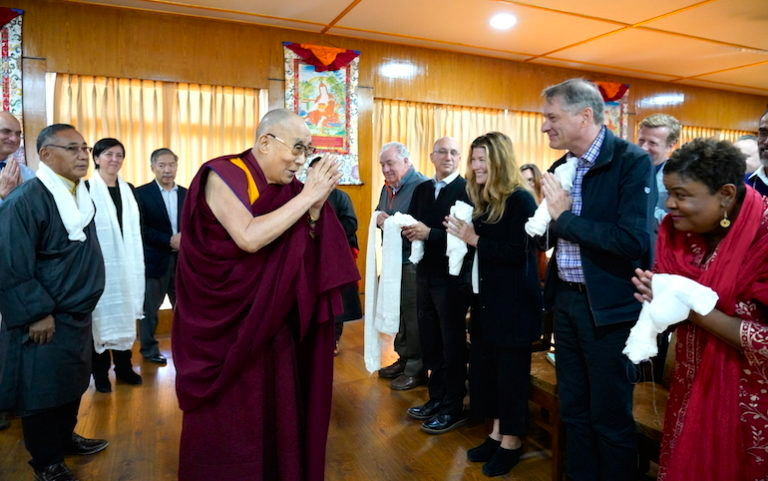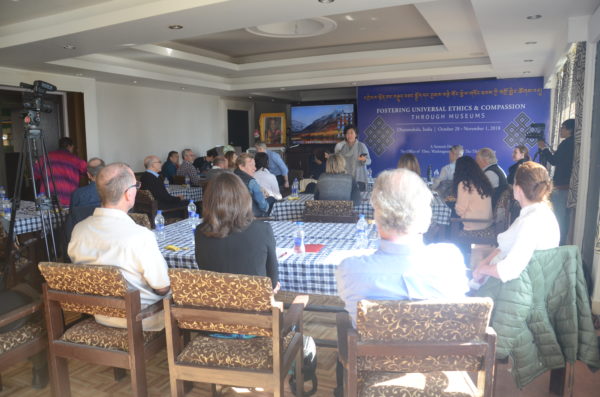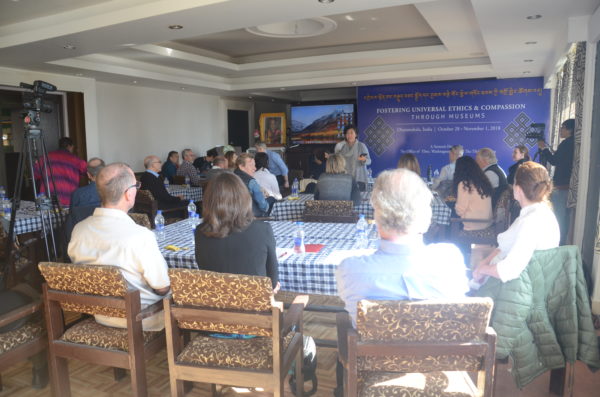Summit for one cause: Fostering Universal Ethics and Compassion through Museums

“Knowledge must be shared to grow a world with more empathy and caring for one another, and museums are the medium.”
Dharamshala: A summit to ‘Foster Universal Ethics and Compassion through Museums’ was held from October 28 to 31, 2018, in Dharamshala, the seat of Central Tibetan Administration (CTA). The event assembled 29 delegates from different museum fields from The United State and Germany along with six Tibet Museum staffs to participate in the summit.
On October 28, 2018, ‘Fostering Universal Ethics and Compassion through Museums’ started its informal reception with the ceremonial lighting of the butter lamp by the Mr. Ngodup Tsering, Representative of His Holiness the Dalai Lama to North America and two members of the organising team Ms. Elif M. Gokcigdem and Mr. Jon Kolkin. Later Mr. Ngodup Tsering and Mr. Tashi Phuntsok, director of the Tibet Museum welcomed the delegates with the presentation of Khatas (Tibetan scarf) to each delegate. As there is a saying in Tibetan custom that “an event is well started with a song to cherish,” – three very talented Tibetan singers performed Tibetan folk songs on the podium to double up the inauguration celebration. Overall summit agenda and overview of the next grand day audience with His holiness were discussed after welcome speech.
In the morning of October 29, 2018, the audience with His Holiness the Dalai Lama and his speech on universal ethics, compassion and practice of empathy officially unfurled the program. He acknowledged delegates the prior importance of compassionate heart and the practice of humanity, explaining others are just secondary necessities and differentiation. Materialistic happiness is temporary. The ultimate happiness comes from the practice of warm heartedness. He further stated that morality comes from within and it needs continuous practice to bring it at the front. Various other topics were also discussed; Global warming, his fourth commitment to revive the ancient Nalanda tradition of India, the practice of peace of mind, the importance of moral education and others. The pivotal thing for all the people to consider is to look on environment issues as an individual responsibility as eventually, people in every corner of the earth will suffer the impact now or later. He also spoke about the importance of museum and its huge opportunities to show people that by cultivating peace of mind one can achieve happy life.He also spoke about the importance of museum and its huge opportunities to show people that by cultivating peace of mind one can achieve happy life.
After the conclusion of meeting with His Holiness, the morning program ended with the tour and refreshment served in the current Tibet Museum located near main temple in Mcleod Ganj. The afternoon session begins at Vaikunth Hotel with museum delegates explaining objectives of their respective museums via ten minutes presentation each. Certain topics like the idea of fostering empathy by Jim Wharton for the conservation concern let people not just only to see but to find close connection amongst different museums by pursuing agency, effectiveness, coherence, and continuity. Wendy Woon from the Museum of Modern Art, New York quoted “we are more than what we possess.” With three inspirational stories of three different women, she disclosed culture is building community and museum is the medium to enjoy, understand and use art to articulate empathy.
Karleen Gardner of Minneapolis Institute of Art explained the dialogic training; teaching with dialogue to connect people and state evidence-based reasoning. She explained Empathy through constructed stories with the theories of transformational learning, critical Pedagogy and growth mindset. Makeba Clay, Chief Diversity Officer at the Phillips Collection, Washington D.C described the meaning of empathy and creative art in creative space whereas Elizabeth Silkes, Executive Director of the International Coalition of Sites of Conscience started up her presentation with a phrase by Ruth Abram that “history gives us perspective, role models and courage.” She enlightened that the past is the starting point and it starts with the root. Dialogue from the past lead forwards to hope for the future by sowing the seed of peace. Ritual as a tool to discover, design and deliver: a design activity was conducted by Kursat Ozenc; a designer and an innovation consultant at SAP Labs, to create a scenario regarding a situation and list down the intention and ideas in support of the effect on the victim. The activity was done in order to bring out a positive outcome from a negative situation. Ritual is an idea to make a person get better and turn a negative situation into positive. There are three levels of the ritual naming Beginner, Mediate, and Advance.

Elif Gokcigdem delivering her presentation in Nyatri Hall in Central Tibetan Administration complex. Second Day. Photo by Tenzin Jigme/DIIR
October 30, 2018, the second day of summit started in a different venue at Nyatri Hall in Gangchen Kysihong, headquarter of CTA where the event started with a group discussion on yesterday’s meeting with His Holiness the Dalai Lama. After that another round of presentations was initiated, with Jon Kolkin making presentation on five senses and Amelia Winger Bearskin on the center of storytelling. Amir Baradaran put light on ‘AR.ti.ficial’ stories focusing on artificial reality and virtual reality. Orna Cohen delivered on the social enterprises and how to raise empathy through exhibitions. A certain medium of exhibitions was introduced like the darkroom exhibition; dialogue in the dark delivered by a blind expert and dialogue in the silence by a deaf expert who teaches with the soundproof space with headphone. Zorana Ivcevic shed light on Emotions, Creativity, and Arts and shared that she had conducted different course sessions around the world to teach emotion and creativity skills through Arts. Each session has a substantial way of practice that states that the first idea will not always be the most original one and the key thing is to practice. Next Elif Gokcigdem and Eliana Grossman imparted another activity to decipher two portraits, with every hint they gave the perspective of the portrait changed. It is that the painting as the power that creates vulnerability and leads to trust and empathy. The second day concluded with group discussion and envisioning for next day schedules.
October 31, 2018, the final day session rose to a different location that connected more to nature and Tibetan culture, oozing peace and calmness with the arrival at Norbulingka Institute of Arts and Culture. Entering inside the monastery where the program was holding took us all to another level of serenity with the aura of tranquillity, dimly lighted hall surrounded by Buddhist tapestry and a large Buddha statue at the center of the temple. The level of peace amplified after a quick meditation session directed by Jon Kolkin. After that, Tom Rockwell explained on the topic ‘Social Inquiry Exhibits’ where he described Empathy is complex. He explained his museum included a space in his museum for ‘Bowl of Give and Take’ where the person decides what the other side person will get. On the other hand, there was ‘Street Smarts’ that conduct social psychology in public space on the street explaining holding hands will create a current of empathy. At last, Philip Himberg regulated the art of storytelling session to describe stages of empathy factor that increases with the time and compatibility. Morning session with the presentation and activities ended with a scrumptious lunch in a cozy outdoor park surrounded by greeneries. After a private tour in smaller groups to explore the institute, participants assembled to head for an outdoor dialogue practice as post-lunch session. Thereafter, the wrap-up session was conducted to discuss what can be done and what is the result of the summit. The first group concluded that empathy and compassion create creativity whereas the second group put forth to inspire and share the conference outcome or experience with their respective colleagues.
The program officially concluded with the farewell dinner at Chonor House, Mcleod Ganj, where different experiences of gratefulness to attend this summit were shared. The event kept museum at the prior importance as it acts as a mediator to connect viscerally and emotionally for the betterment of the community by the exploration of the rich diversity of human experience and understanding. As a co-host of the museum summit, Tashi Phuntsok, director of the Tibet Museum, expressed how he himself and the participating staff of the Tibet Museum are grateful for the opportunity to host this very important museum summit and gained different aspects of knowledge on various objectives of different museums through this summit. He also thanked organizers; The Office of Tibet Washington D.C, Jon Kolkin Fine Art Photography, and ‘the Empathy-Building Through Museums Initiative’ for congregating different delegates from various museums and Art field in one summit to serve a higher objective to foster universal ethics and compassion through museums.
Report filed by Kunga Choedon, Production and Collection Officer, the Tibet Museum

Six Tibet Museum staffs participating along with 29 delegates from US and Germany. Third day/ Norbulingka. Photo by Tenzin Jigme/DIIR
